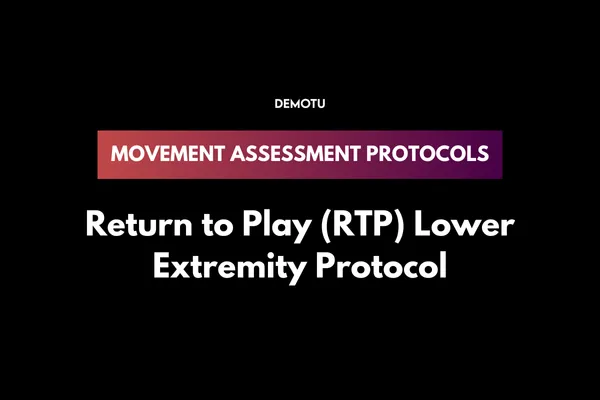
Return to Play (RTP) Lower Extremity Protocol: Essential Assessments for ACL Rehab and Injury Recovery
Movement Analysis, Workout Builder
After a lower extremity injury, especially an ACL tear, a carefully structured Return to Play (RTP) Protocol is essential for athletes to safely transition back to their sport. Demotu’s RTP Lower Extremity Protocol is designed for Athletic Trainers and rehabilitation professionals to comprehensively assess an athlete’s readiness for sport, focusing on proprioception, functional strength, and power. These assessments are invaluable for ACL rehab and torn ACL rehab cases, where returning to sport prematurely can increase the risk of re-injury.
This protocol gives Athletic Trainers reliable, measurable data on key performance indicators like single-leg stability, functional strength, and explosive power, allowing for informed RTP decisions that prioritize athlete safety and long-term performance.
Return to Play (RTP) Lower Extremity Protocol
Functional Assessments
1. Single Leg Balance
Focus: Proprioception
The single leg balance test evaluates proprioceptive control in the injured leg, which is often compromised following ACL injuries and lower extremity surgeries. Instruct the athlete to balance on the injured leg, maintaining stability without excessive swaying or compensations. This assessment tests the ability of the knee and hip stabilizers to support the body in a static position, which is crucial for reducing the risk of re-injury when returning to high-impact movements.
2. Single Leg Hinge
Focus: Functional strength
The single leg hinge movement, similar to a single-leg deadlift, is a functional test for assessing hip and knee strength as well as balance. In this test, the athlete performs a controlled hip hinge while balancing on the injured leg, engaging the glutes and hamstrings for stability. Single leg hinges are particularly useful in ACL rehab because they mimic the type of single-leg strength needed for safe, effective movement on the field or court. Observing for any compensations or instability during this exercise can reveal lingering weaknesses that may put the athlete at risk if they return to sport too soon.
3. Countermovement Jump
Focus: Power assessment
The countermovement jump evaluates explosive power in the lower body, which is essential for athletes returning to high-impact sports after an ACL tear. Measuring vertical jump height and observing symmetry between legs helps identify any deficits in power or control in the injured leg. This test can reveal whether the athlete has regained enough power and balance to withstand the dynamic forces of sport-specific movements, such as jumping, sprinting, and cutting. For athletes in torn ACL rehab, demonstrating even power distribution between legs is a critical milestone before advancing to unrestricted play.
Joint Comparisons
Knee Flexion/Extension: Assessing the range of motion in the knee, especially after ACL reconstruction, is crucial for determining if the athlete has regained full mobility and strength. Limited knee flexion or extension can indicate underlying stiffness or weakness that may lead to compensatory movements and increased re-injury risk.
Hip Flexion/Extension: Evaluating hip mobility and strength helps assess the functional integration of the entire lower limb. Poor hip control or strength can lead to compensations that compromise knee stability, especially under dynamic conditions.
Research & Insights
Research has shown that functional testing of single-leg stability and jump performance are key indicators of RTP readiness, especially for athletes recovering from ACL tears or other knee injuries. Standard RTP protocols emphasize assessments of stability, strength, and power, all of which are essential for mitigating the risk of re-injury. Proper functional recovery in these areas is especially important in ACL rehab protocols, as athletes are often at a heightened risk for re-injury if they return to sport without sufficient single-leg control and power.
Supporting ACL Rehab and Return to Sport with Demotu
Demotu’s RTP Lower Extremity Protocol goes beyond the basics, providing Athletic Trainers with precise data on each athlete’s recovery progress. This protocol helps trainers monitor improvements in knee and hip stability, strength, and power, allowing for adjustments to the rehab program as needed. By accurately tracking these metrics, trainers can make more informed RTP decisions, reducing the likelihood of re-injury for athletes recovering from ACL surgery or other serious knee injuries.
The workout builder and exercise builder features in Demotu also allow trainers to create individualized, progressive rehab programs for ACL recovery. For example:
For Proprioception: Balance exercises on unstable surfaces (e.g., BOSU ball) and single-leg

stance drills can enhance proprioceptive feedback, strengthening knee stability.
For Functional Strength: Single-leg squats and split squats focus on regaining strength in the injured leg, while ensuring proper hip-knee alignment.
For Power and Explosive Strength: Exercises like depth jumps, box jumps, and plyometric lunges help restore power and explosiveness, essential for returning to high-impact sports.
Building Confidence and Reducing Injury Risk with Targeted Protocols
Rehab following an ACL tear or knee injury is a long process that requires a methodical approach to regain both confidence and strength. Demotu’s RTP Protocol empowers Athletic Trainers with structured assessments that provide clarity on the athlete’s readiness to return to sport. Through detailed feedback on single-leg stability, jump height, and functional strength, trainers can ensure that each athlete has achieved a baseline of stability and power that minimizes the risk of re-injury.
The ability to create personalized ACL rehab exercises and torn ACL rehab programs within Demotu’s app also allows for a gradual return-to-sport process, targeting each athlete’s specific needs. By using Demotu’s tools, Athletic Trainers can support athletes in building resilience and optimizing recovery outcomes, ultimately leading to a safer and more confident return to sport.
Click Here To Use Motion Capture for Movement Assessments - Free Today!